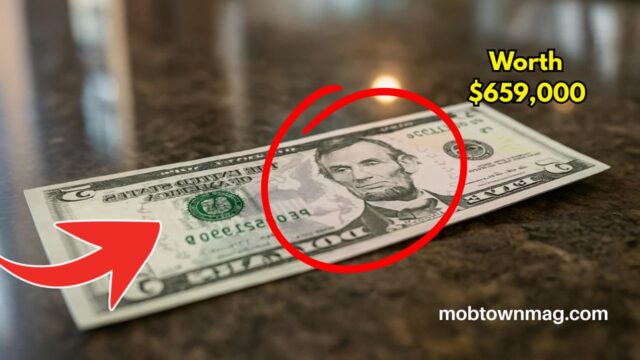In the world of collecting money—called numismatics—some banknotes become famous because they are rare and have interesting features. A recent example is a $5 bill that sold for an amazing $659,000 at auction.
This bill has two special traits: a radar serial number (a number that reads the same forward and backward) and a handwritten note.
Both of these make the bill very rare and exciting for collectors. Below, you’ll read a clear and simple explanation of what makes this bill so special and why it fetched such a high price.
What Is Special About This $5 Bill?
This isn’t just any $5 bill. It has two unique features:
- A radar serial number, which is a palindrome—meaning it reads the same from left to right and right to left.
- A handwritten note, which adds a personal and historical touch.
Collectors love finding bills with unusual serial numbers or messages. Combined with the bill’s age and good condition, these traits make it stand out and become extremely valuable.
What Is a Radar Serial Number?
A radar serial number is a type of palindrome. For example, a number like “12344321” is identical when read forwards or backwards—that’s why it’s called a radar number.
These serial numbers are very rare on banknotes, so collectors are eager to own them when they appear. That’s one big reason this $5 bill was so valuable.
Why a Handwritten Note Matters
Palindrome: Having a handwritten message on a bill makes it more than just money—it becomes a historical artifact. The message might show personal thoughts, a special date, or even a secret message from the past. These added stories can increase a bill’s value because they are one-of-a-kind.
Why Did This Bill Fetch $659,000?
Let’s break down why this bill sold for so much:
- Rarity: Radar serial bills are extremely rare.
- Condition: The bill was in good shape, which collectors value highly.
- Extra uniqueness: The handwritten note made it even more special.
- Collector excitement: Many passionate collectors bid, driving the price up.
These factors combine to make it a once-in-a-lifetime find.
What This Means for Money Collecting
If you enjoy collecting rare bills, this sale shows that special features—like odd serial numbers or messages—can bring huge prices. As more people learn about numismatics, demand for unusual notes is growing. You might find something valuable just in your own wallet or home.
Details of the $659,000 $5 Bill
| Feature | Description |
|---|---|
| Denomination | $5 U.S. dollar bill |
| Serial Number Type | Radar (palindrome reading same both ways) |
| Special Marking | Handwritten note adds personal/historical significance |
| Auction Price | $659,000 |
| Why Valuable? | Rare serial, good condition, unique annotation, collector demand |
This remarkable $5 bill—selling for $659,000—shows how rarity, condition, and personal touches can make a simple piece of paper incredibly valuable.
With its radar serial number and handwritten note, it became a treasure for collectors and a reminder that even everyday objects can hold great stories. Keep an eye on your wallets or family keepsakes—you might be sitting on something amazing without even knowing it.
FAQs
What is a radar serial number?
A radar serial number is a special type of banknote serial that reads the same forward and backward—making it rare and collectible.
Why does a handwritten note increase value?
Because it adds history and personal meaning, turning an ordinary bill into something unique—a story on paper.
Can I check if my own bill has a rare serial number?
Yes! Look for palindromes or repeat patterns. You can also use online tools or ask currency experts to help verify its rarity.




